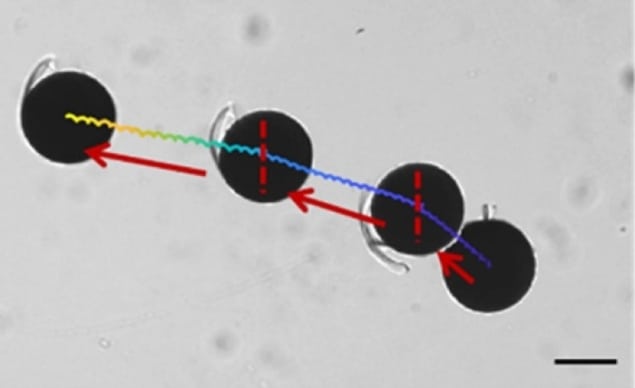Liquid crystals bring robotics to the microscale
05 Oct 2022 Katherine Skipper
On the move: Time sequence showing a robot swimmer following a curved trajectory to the upper left. The motion occurs over 520 s and the period of the external field is changed at the locations indicated by the red dashed lines. The scale bar is 50 microns. (Courtesy: T Yao et al/Science Advances)
Scientists in the US and Slovenia have built a tiny swimming robot that paddles using liquid crystals. Kathleen Stebe of the University of Pennsylvania, alongside collaborators at the University of Ljubljana, studied rotating microparticles embedded in a liquid crystal. They discovered that the rotation triggers sudden rearrangements of the surrounding liquid crystal molecules, which acts as a swim stroke and propels the microrobot. In papers published in Science Advances and Advanced Functional Materials, they investigate this propulsion and use it to build a cargo carrying functional nanorobot.
“Like all the best projects, this project had elements of discovery and serendipity,” says Stebe, who uses the concept of “physical intelligence” to build robots below the scale of a microchip. Rather than being executed by a computer, the behaviour of the robot is encoded into the interaction with its environment. Liquid crystals are a promising material in which to build micromachines because they are anisotropic, capable of breaking symmetry around even spherical obstacles. They are also non-Newtonian and generate complex flows when pushed out of equilibrium.
“Serendipitous” discovery
Stebe’s team started with the idea that liquid crystals would add functionality to an existing system: ferromagnetic discs rotating in a magnetic field. Embedded particles produce singularities in the alignment of the liquid crystal and the researchers predicted that the interaction between singularities would allow a rotating cross shaped disc to capture and release a smaller spherical cargo particle. In the lab, they observed that as the disc rotated, the singularity hopped from arm to arm with the cargo particle following. In these experiments, which were led by graduate student Tianyi Yao (now at Intel), they also saw something unexpected: as they spun, the discs were swimming through the liquid crystal .
Video showing a topological defect-propelled swimmer
Video showing a topological defect-propelled swimmer. (Courtesy: T Yao/Science Advances)
Play Video
Wanting to understand this phenomenon, Stebe and team reduced the complexity of the system to a rotating circular disc. Again, they observed locomotion through the liquid crystal. A clue to the propulsion mechanism was a thin line, visible in a microscope and indicating disorder in the liquid crystal. This line emanated from the singularity and swept across the face of the disc (see above video). Stebe’s team collaborated with Miha Ravnik’s group at the University of Ljubljana to perform numerical simulations of the liquid crystal around the singularity. The simulations, which were performed by postdoc Žiga Kos, confirmed the structure of the defect in equilibrium and suggested that the elasticity of the liquid crystal was key to the propulsion. By combining experiment and simulation, the researchers developed a theory to describe the swimming robots.
Stretchy defects enable swimming
When the disc rotates, the defect initially remains pinned to the particle, stretching the liquid crystal in a line around the sharp edge like an elastic band. Eventually the energy of this line defect gets so big that it breaks free and sweeps suddenly across the face of the particle, like an audience wave moving through a stadium.
This sudden rearrangement exerts a force on one face of the disc, tilting it onto its edge. By the time it tilts back, the liquid crystal has returned to its unstretched configuration, and this simple movement propels the particle. The researchers also demonstrated that the swimmer can be manipulated in a curved path by changing the frequency of the applied magnetic field.
Four-armed microrobot
Video showing a four-armed microrobot in action. (Courtesy: T Yao/Advanced Functional Materials)
Play Video
The researchers expect that investigating the microrobots further will keep them busy (see above video). Stebe says, “It’s an exciting time, because we saw something lovely, we were able to harness it in some advanced functional materials. We were able to explain many important aspects, and we were able to unveil where we need to do more work as a community.” Stebe has many questions about the interaction between the liquid crystal and the sharp edge of the disc and hopes that understanding the fundamental aspects of the swimmer will give them more power to design functional microrobots in the future.

Katherine Skipper is a PhD student contributor to Physics World. Katherine is based at the University of Bristol, where she studies experimental active matter. Find out more about our student contributor networks
from physicsworld.com 30/10/2022

Δεν υπάρχουν σχόλια:
Δημοσίευση σχολίου